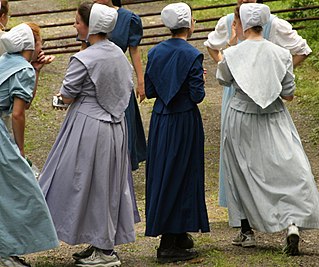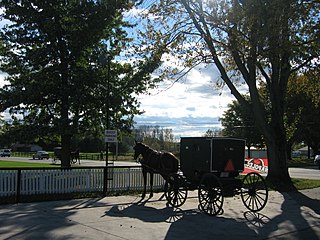Related Research Articles

Mennonites are a group of Anabaptist Christian church communities tracing their roots to the Radical Reformation. The name is derived from one of the early prominent leaders of the Anabaptist movement, Menno Simons (1496–1561). Through his writings about Reformed Christianity during the Radical Reformation, Simons articulated and formalized the teachings of earlier Swiss founders, with the early teachings of the Mennonites founded on the belief in both the mission and ministry of Jesus, which the original Anabaptist followers held with great conviction, despite persecution by various Roman Catholic and Mainline Protestant states. Formal Mennonite beliefs were codified in the Dordrecht Confession of Faith in 1632, which affirmed "the baptism of believers only, the washing of the feet as a symbol of servanthood, church discipline, the shunning of the excommunicated, the non-swearing of oaths, marriage within the same church", strict pacifistic physical nonresistance, anti-Catholicism and in general, more emphasis on "true Christianity" involving "being Christian and obeying Christ" as they interpret it from the Holy Bible.

Pennsylvania Dutch, sometimes referred to as Pennsylvania German, is a variety of Palatine German, also known as Palatinate German or Palatine Dutch, spoken by the Pennsylvania Dutch, including the Old Order Amish, Old Order Mennonites, Fancy Dutch, and other descendants of German immigrants in the United States and Canada. There are approximately 300,000 native speakers of Pennsylvania Dutch in the United States and Canada.

The Old Order River Brethren are a River Brethren denomination of Anabaptist Christianity with roots in the Radical Pietist movement. As their name indicates, they are Old Order Anabaptists.
Old Order Mennonites form a branch of the Mennonite tradition. Old Order are those Mennonite groups of Swiss German and south German heritage who practice a lifestyle without some elements of modern technology, still drive a horse and buggy rather than cars, wear very conservative and modest dress, and have retained the old forms of worship, baptism and communion.

The David Martin Mennonites, officially called Independent Old Order Mennonite Church or Independent Old Order Mennonites, are a horse and buggy group of Canadian Old Order Mennonites that is moderate concerning the use of modern technologies and that emerged in 1917. They numbered about 3,500 people in 2010 and live in Wellington County, Ontario and the Waterloo Region. In 2020 they now also live in The Municipality of Grey Highlands, Simcoe County, and Township of Southgate. They do not cooperate with other Old Order groups.
The Stauffer Mennonites, or "Pikers", are a group of Old Order Mennonites. They are also called "Team Mennonites", because they use horse drawn transportation. In 2015 the Stauffer Mennonites had 1,792 adult members.
The Beachy Amish Mennonites, also known as the Beachy Mennonites, are an Anabaptist group of churches in the Conservative Mennonite tradition that have Amish roots. Although they have retained the name "Amish" they are quite different from the Old Order Amish: they do not use horse and buggy for transportation, with a few exceptions they do not speak Pennsylvania Dutch anymore, nor do they have restrictions on technology except for radio and television. In the years 1946 to 1977 a majority of the Beachy Amish incorporated certain elements of revivalist practice, such as the preaching of the New Birth. The traditionalists who wanted to preserve the old Beachy Amish ways then withdrew and formed their own congregations. Today they are known as Midwest Beachy Amish Mennonites or Old Beachy Amish.

The Groffdale Conference Mennonite Church, also called Wenger Mennonites, is the largest Old Order Mennonite group to use horse-drawn carriages for transportation. Along with the automobile, they reject many modern conveniences, while allowing electricity in their homes and steel-wheeled tractors to till the fields. Initially concentrated in eastern Lancaster County, Pennsylvania, their numbers had grown to 22,305 people resided in eight other states as of 2015. They share the pulpit with the Ontario Mennonite Conference but have some differences in Ordnung.

The Amish, formally the Old Order Amish, are a group of traditionalist Anabaptist Christian church fellowships with Swiss German and Alsatian origins. They are closely related to Mennonite churches, a separate Anabaptist denomination. The Amish are known for simple living, plain dress, Christian pacifism, and slowness to adopt many conveniences of modern technology, with a view neither to interrupt family time, nor replace face-to-face conversations whenever possible, and a view to maintain self-sufficiency. The Amish value rural life, manual labor, humility and Gelassenheit.
The Markham-Waterloo Mennonite Conference (MWMC) is a Canadian, progressive Old Order Mennonite church established in 1939 in Ontario, Canada. It has its roots in the Old Order Mennonite Conference in Markham, Ontario, and in what is now called the Regional Municipality of Waterloo. The Conference adheres to the 1632 Dordrecht Confession of Faith. The Markham-Waterloo Mennonite Conference is in fellowship with two similar car-driving Old Order Mennonite churches: the Weaverland Mennonite Conference and the Ohio-Indiana Mennonite Conference.
The Noah Hoover Mennonites, called "Old Order Mennonite Church (Hoover)" by the Mennonite World Conference, and sometimes called "Scottsville Mennonites”, are a group of very plain Old Order Mennonites that originally came from the Stauffer Mennonites and later merged with several other groups. Today it is seen as an independent branch of Old Order Mennonites. The group differs from other Old Order Mennonites by having settlements outside the US and Canada and by attracting new members from other groups on a larger scale. They have more restrictions on modern technology than all other Old Order Mennonite groups. They are rather intentionalist minded than ultra traditional.
The Ontario Mennonite Conference is a moderate Old Order Mennonite group in the Canadian province of Ontario, that was formed in 1889 as a reaction to modernizing trends among the Mennonites in Ontario. The members use horse and buggy for transportation. As of 2020, they also have a colony in the Canadian province of Prince Edward Island.
The Virginia Old Order Mennonite Conference, also called Cline Mennonites or Cline-Showalter group, is an Old Order Mennonite group to use horse-drawn carriages for transportation. It separated from the Virginia Mennonite Conference in 1901. The members of the group speak English only, unlike almost all other horse and buggy Old Order Mennonite groups, who speak Pennsylvania German as their first language. In recent years the group sometimes uses the name "Riverdale Old Order Mennonite Church".
Elmo Stoll was a former Old Order Amish bishop, writer and founder of the "Christian Communities". He was one of the few Amish who "have risen to prominence over the years".
The "Christian Communities" were Christian intentional communities with an Anabaptist worldview, founded and led by Elmo Stoll, a former Old Order Amish bishop. They were founded in 1990 and disbanded some two years after Stoll's early death in 1998. At the time of Stoll's death there were five "Christian Communities", four in the U.S. and one in Canada. G.C. Waldrep calls them "perhaps the most important "para-Amish" group".
The Caneyville Christian Community was an Anabaptist community, located in Caneyville, Kentucky, living a plain conservative lifestyle, true to the vision of former Old Order Amish bishop Elmo Stoll. G. C. Waldrep classifies them as "para-Amish". Among Anabaptists the community is often simply called "Caneyville".
Believers in Christ is a Plain horse-and-buggy Anabaptist Christian community at Cane Creek, Lobelville, Tennessee, that is rather intentional than traditional. They are sometimes seen as either Amish or Old Order Mennonite. G. C. Waldrep classifies them as "para-Amish". Among Anabaptists the community is often simply called "Lobelville".
A Seeker is a person likely to join an Old Order Anabaptist community, like the Amish, the Old Order Mennonites, the Hutterites, the Old Order Schwarzenau Brethren or the Old Order River Brethren. Among the 500,000 members of such communities in the United States there are only an estimated 1,200 to 1,300 outsiders who have joined them.

Old Order Anabaptism encompasses those groups which have preserved the old ways of Anabaptist Christian religion and lifestyle.
The Old Beachy Amish or Old Beachy Amish Mennonites, also called Midwest Beachy Amish Mennonites, are a Plain, car-driving Beachy Amish group, that preserves the old ways of the Beachy Amish including the German language. They live in Kentucky and Illinois. They are part of the Amish Mennonite movement in a broader sense, but they are not an organized denomination.
References
- ↑ Scott 1996, pp. 18–20.
- ↑ "David Martin Mennonites (Ontario, Canada)". GAMEO. Retrieved 2018-04-30.
- ↑ Schrock 2001, pp. 192–212.
- ↑ Martin 2003, p. 179.
- 1 2 3 4 5 6 "Orthodox Mennonite Church". GAMEO. Retrieved 2018-04-30.
- ↑ Martin 2003, p. 180.
- ↑ Martin 2003, p. 183.
- ↑ Martin 2003, p. 181.
- 1 2 Scott 1996, p. 67.
- ↑ "Elam M. Martin Mennonites (Ontario, Canada)". GAMEO. Retrieved 2018-04-30.
- ↑ Donnermeyer & Anderson 2015, p. 231.
- ↑ Donnermeyer & Anderson 2015, p. 244.
- ↑ "Westbourne Orthodox Mennonite Church (Gladstone, Manitoba, Canada)". GAMEO. Retrieved 2018-04-30.
- ↑ Minardi, Sheri (2016-03-07). "The Mennonites of Algoma: East of Sault Ste. Marie, Ontario". Northern Ontario Travel. Retrieved 2022-07-16.
- 1 2 "Visiting The Desbarats, Ontario Old Order Mennonite Community". Amish America. 2015-08-05. Retrieved 2022-07-16.
- ↑ Martin, Rick (2020-11-21). "The Orthodox Mennonite Church". 500 Years of Migration. Retrieved 2022-07-16.
- ↑ Martin 1998, p. 7.
- ↑ Kraybill 2010, pp. 252, 258.
- ↑ Kraybill & Hostetter 2001, p. 248.